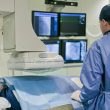Courtesy of Dr. Carlos Fava. The incidence of unprotected left main severe stenosis ranges between 4 and 8%, and it’s mostly associated with multivessel disease. The use of left ventricular support devices in high risk unprotected left main PCI is on the rise, but not much information available in this regard. Read also: “Prior assistance...
Multivessel Disease and Severe Carotid Stenosis: How to Proceed
Myocardial revascularization surgery (CABG) is the most frequent of all cardiovascular surgeries and is still the gold standard to treat multivessel disease. Between 6 and 8% of these patients present concomitant carotid stenosis and it is associated with increased peri and post procedural stroke rates during and after surgery. To prevent carotid stenosis, either PCI or endarterectomy...
Early Coronary Angiography in High-Risk Non-ST-Elevation ACS
Coronary angiography is essential for patients admitted with non-ST-elevation acute coronary syndrome, since it allows physicians to confirm the diagnosis, stratify the risk, and define the revascularization and antithrombotic management strategies. There is no doubt that these patients should be studied invasively, but the timing for that is still uncertain. Coronary catheterization within...
With Absorb Out, New Resorbable Scaffolds Have Come onto the Market
By restoring vascular physiology and eliminating the inflammatory focus and the chance of fracture and neo atherosclerosis inherent to DES, bioresorbable scaffolds offer the potential to improve long term outcomes. A number of bioresorbable materials have been tested, mainly polylactic acid, with several limitations that have taken the Absorb bioresorbable scaffold out of the market....
Frequency and Evolution of Cardiac Perforation in Patients with a History of MRS
Courtesy of Dr. Carlos Fava. Coronary perforation (CP) is a very uncommon event (≈0.4%), associated with severe complications that entail risk of death. It has usually been related to patients with a history of myocardial revascularization surgery (MRS). However, this group usually presents lower rates of cardiac tamponade due to pericardial fibrosis caused by surgery. This...
Endarterectomy vs. Stenting in Asymptomatic Carotid Artery Stenosis
The comparative efficacy and safety of carotid stenting vs. endarterectomy in asymptomatic carotid stenosis patients remains controversial and, what is worse, consensus seems unlikely in the near future. Given the lack of definite evidence, several meta-analyzis and systematic reviews have been produced in an attempt to shed some light on this matter. This study included all...
New Strategies for the Femoropopliteal Artery
Courtesy of Dr. Carlos Fava. The incidence of peripheral vascular disease is clearly increasing, progressing towards critical ischemic claudication and amputation. Angioplasty is currently the treatment of choice for these pathologies. Several times, an implanted stent ends up cracking due to extensive calcification, increasing the rate of restenosis and worsening critical ischemia. Technological development on drug-eluting...
Very Late Thrombosis in Bioresorbable Scaffolds
The presence of a metallic device interrupts normal laminar flow and creates an artery environment that favors thrombosis, leaving the vessel vulnerable to very late thrombosis. Dual antiplatelet therapy, a better implantation technique, and several improvements in new drug-eluting stents (DES) (thinner struts, and higher polymer stability and biocompatibility) have lowered significantly the incidence of...
Conscious Sedation in TAVR: Is It Advisable?
The fundamental advantage offered by transcatheter aortic valve replacement (TAVR) has always been the fact that it is less invasive than surgical valve replacement. So far, most improvements for these devices have derived in less invasiveness (e.g., by improving the profile of the eluting system). However, there are also cases of “deployment” reduction during the...
Introducing the number one enemy of PCI: diabetes
About 25% of patients with multivessel disease undergoing myocardial revascularization surgery or PCI have diabetes. In this subgroup, the benefit of surgery in terms of mortality has long been shown: in the BARI study (Bypass Angioplasty Revascularization Investigation) patients undergoing PCI had close to double the mortality rate at 5 years compared to those...









